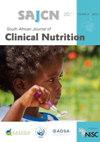The use of linear programming to determine whether breastfed infants can achieve a nutritionally adequate complementary feeding diet: a case study of 6–11-month-old infants from KwaMashu, KwaZulu-Natal, South Africa
IF 0.6
Q4 NUTRITION & DIETETICS
引用次数: 1
Abstract
Objectives: The objectives of this study were to ascertain whether the nutrient requirements of 6–11-month-old infants can be met with a food-based approach, and to identify the nutrients of which it is difficult to achieve adequate intakes. Design, setting and subjects: A cross-sectional survey and interviews with mothers and caregivers from the KwaMashu Community Health Centre were conducted. One hundred and thirty-four interviews were completed. This information provided the food consumption input for the model using Optifood software. Results: The results revealed that with the current food pattern of infants from the study group in KwaMashu, iron, zinc and calcium are nutrients whose requirements are likely not to be met in the diet. The percentage RNI (recommended nutrient intake) for iron was 25.2%, zinc 51.3% and calcium 77%. Nutrient intakes for these nutrients of concern improved in the ‘No pattern’ diet but iron and zinc intakes remained below the RNI. According to the best diets modelled by Optifood, it appears that infants in KwaMashu would be able to achieve the recommended intakes of energy, protein, and 8 of the 11 micronutrients, as long as breastfeeding on demand continues during the complementary feeding phase. Conclusions: This study calls into question the continued food-based focus to ensure nutrient adequacy in infants. In conjunction with efforts to improve household food security and continued support and promotion of breastfeeding for the first 2 years of life, targeted micronutrient supplementation may be needed to ensure the optimal growth and development of infants in South Africa.使用线性规划来确定母乳喂养的婴儿是否能够获得营养充足的补充喂养饮食:对南非夸祖鲁-纳塔尔省夸马舒市6-11个月大婴儿的个案研究
目的:本研究的目的是确定6-11个月大婴儿的营养需求是否可以通过基于食物的方法来满足,并确定难以获得足够摄入量的营养素。设计、设置和受试者:对KwaMashu社区卫生中心的母亲和护理人员进行了横断面调查和访谈。共完成了134次采访。这些信息为使用Optifood软件的模型提供了食物消耗输入。结果:研究结果表明,根据夸马舒研究组婴儿目前的饮食模式,铁、锌和钙是饮食中可能无法满足其需求的营养素。铁的RNI(推荐营养素摄入量)百分比为25.2%,锌为51.3%,钙为77%。在“无模式”饮食中,这些令人担忧的营养素的营养素摄入量有所改善,但铁和锌的摄入量仍低于RNI。根据Optifood模拟的最佳饮食,只要在补充喂养阶段继续按需母乳喂养,KwaMashu的婴儿似乎能够达到推荐的能量、蛋白质和11种微量营养素中的8种。结论:这项研究对继续以食物为基础来确保婴儿营养充足提出了质疑。在努力改善家庭粮食安全以及继续支持和促进生命头2年的母乳喂养的同时,可能需要有针对性地补充微量营养素,以确保南非婴儿的最佳生长发育。
本文章由计算机程序翻译,如有差异,请以英文原文为准。
求助全文
约1分钟内获得全文
求助全文
来源期刊

South African Journal of Clinical Nutrition
NUTRITION & DIETETICS-
CiteScore
2.50
自引率
9.10%
发文量
21
期刊介绍:
1.The Journal accepts articles from all basic and applied areas of dietetics and human nutrition, including clinical nutrition, community nutrition, food science, food policy, food service management, nutrition policy and public health nutrition. 2.The Journal has a broad interpretation of the field of nutrition and recognizes that there are many factors that determine nutritional status and that need to be the subject of scientific investigation and reported in the Journal. 3.The Journal seeks to serve a broad readership and to provide information that will be useful to the scientific community, the academic community, government and non-government stakeholders in the nutrition field, policy makers and industry.
 求助内容:
求助内容: 应助结果提醒方式:
应助结果提醒方式:


